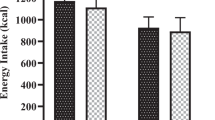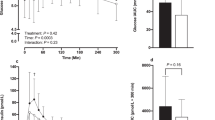Abstract
Background:
It is hypothesized that a solid form of food or food components suppresses subjective appetite and short-term food intake (FI) more than a liquid form.
Objective:
To compare the effect of eating solid vs drinking liquid forms of gelatin, sucrose and its component mixtures, and whey protein, on subjective appetite and FI in young men.
Design and subjects:
A randomized crossover design was used in three experiments in which the subjects were healthy males of normal weight. Solid and liquid forms of gelatin (6 g) (experiment 1, n=14), sucrose (75 g) and a mixture of 50% glucose/50% fructose (G50:F50) (experiment 2, n=15), and acid and sweet whey protein (50 g) (experiment 3, n=14) were compared. The controls were water (experiments 1 and 3) and calorie-free sweetened water with gelatin (sweet gelatin, experiment 1) or calorie-free sweetened water (sweet control, experiment 2). Subjective average appetite was measured by visual analog scales over 1 h and ad libitum FI was measured 1 h after treatment consumption.
Results:
Average appetite area under the curve was not different between solid and liquid forms of sugars, but was larger, indicating greater satiety for solid compared with liquid forms of gelatin and sweet, but not acid whey protein. The FI was not different from that of control because of solid or liquid sugars or gelatin treatments. However, both solid and liquid forms of whey protein, with no difference among them, suppressed FI compared with control (P<0.05).
Conclusion:
Macronutrient composition is more important than physical state of foods in determining subjective appetite and FI.
This is a preview of subscription content, access via your institution
Access options
Subscribe to this journal
Receive 12 print issues and online access
$259.00 per year
only $21.58 per issue
Buy this article
- Purchase on Springer Link
- Instant access to full article PDF
Prices may be subject to local taxes which are calculated during checkout


Similar content being viewed by others
References
Anderson G, Aziz A, Abou Samra R . Physiology of food intake regulation: Interaction with dietary components. In: Rigo J ZE (ed). Protein and Energy Requirements in Infancy and Childhood, vol. 58. Nestle: Nestec Ltd., Vevey/S. Karger AG. Basal, Nestle Nutrition Workshop Series Pediatric Program: Switzerland, 2006, pp 133–145.
Anderson GH . Sugars-containing beverages and post-prandial satiety and food intake. Int J obes (Lond) 2006; 30: S52–S59.
DiMeglio DP, Mattes RD . Liquid versus solid carbohydrate: effects on food intake and body weight. Int J Obes Relat Metab Disord 2000; 24: 794–800.
Mattes RD . Beverages and positive energy balance: the menace is the medium. Int J Obes (Lond) 2006; 30: S60–S65.
Wolf A, Bray GA, Popkin BM . A short history of beverages and how our body treats them. Obes Rev 2008; 9: 151–164.
Ludwig DS, Peterson KE, Gortmaker SL . Relation between consumption of sugar-sweetened drinks and childhood obesity: a prospective, observational analysis. Lancet 2001; 357: 505–508.
Mourao DM, Bressan J, Campbell WW, Mattes RD . Effects of food form on appetite and energy intake in lean and obese young adults. Int J Obes (Lond) 2007; 31: 1688–1695. Epub 2007 Jun 1619.
Drewnowski A, Bellisle F . Liquid calories, sugar, and body weight. Am J Clin Nutr 2007; 85: 651–661.
Anderson GH . Much ado about high-fructose corn syrup in beverages: the meat of the matter. Am J Clin Nutr 2007; 86: 1577–1578.
Kissileff HR . Effects of physical state (liquid-solid) of foods on food intake: procedural and substantive contributions. Am J Clin Nutr 1985; 42: 956–965.
Hulshof T, De Graaf C, Weststrate JA . The effects of preloads varying in physical state and fat content on satiety and energy intake. Appetite 1993; 21: 273–286.
Almiron-Roig E, Flores SY, Drewnowski A . No difference in satiety or in subsequent energy intakes between a beverage and a solid food. Physiol Behav 2004; 82: 671–677.
Kissileff HR, Gruss LP, Thornton J, Jordan HA . The satiating efficiency of foods. Physiol Behav 1984; 32: 319–332.
Rolls BJ, Fedoroff IC, Guthrie JF, Laster LJ . Foods with different satiating effects in humans. Appetite 1990; 15: 115–126.
Mattes RD . Dietary compensation by humans for supplemental energy provided as ethanol or carbohydrate in fluids. Physiol Behav 1996; 59: 179–187.
Lavin JH, French SJ, Ruxton CH, Read NW . An investigation of the role of oro-sensory stimulation in sugar satiety? Int J Obes Relat Metab Disord 2002; 26: 384–388.
Haber GB, Heaton KW, Murphy D, Burroughs LF . Depletion and disruption of dietary fibre. Effects on satiety, plasma-glucose, and serum-insulin. Lancet 1977; 2: 679–682.
Stubbs RJ, Whybrow S . Energy density, diet composition and palatability: influences on overall food energy intake in humans. Physiol Behav 2004; 81: 755–764.
Herman C, Polivy J . Restrained eating. In: AJ Stunkard (ed). Obesity. WB Saunders and Co: Philadelphia, PA, 1980; 208–217.
Akhavan T, Anderson GH . Effects of glucose-to-fructose ratios in solutions on subjective satiety, food intake, and satiety hormones in young men. Am J Clin Nutr 2007; 86: 1354–1363.
Anderson GH, Tecimer SN, Shah D, Zafar TA . Protein source, quantity, and time of consumption determine the effect of proteins on short-term food intake in young men. J Nutr 2004; 134: 3011–3015.
Akhavan T, Luhovyy BL, Brown PH, Cho CE, Anderson GH . The Effect of Pre-meal Consumption of Whey Protein and its Hydrolysate on Food Intake and Post-Meal Glycemia and Insulin Responses in Young Adults. Am J Clin Nutr 2010; 91: 966–975.
Tournier A, Louis-Sylvestre J . Effect of the physical state of a food on subsequent intake in human subjects. Appetite 1991; 16: 17–24.
Bray GA, Nielsen SJ, Popkin BM . Consumption of high-fructose corn syrup in beverages may play a role in the epidemic of obesity. Am J Clin Nutr 2004; 79: 537–543.
Yvon M, Beucher S, Guilloteau P, Le Huerou-Luron I, Corring T . Effects of caseinomacropeptide (CMP) on digestion regulation. Reprod Nutr Dev 1994; 34: 527–537.
Beucher S, Levenez F, Yvon M, Corring T . Effects of gastric digestive products from casein on CCK release by intestinal cells in the rat. J Nutr Biochem 1994; 5: 6.
Akhavan T, Panahi S, Anderson GH, Luhovyy BL . Application of dairy-derived ingredients in food intake and metabolic regulation. In: Corredig M (ed). Dairy-derived ingredients: Food and nutraceutical uses. Woodhead Publishing Ltd: Cambridge, UK, 2009, pp 212–237.
Luhovyy BL, Akhavan T, Anderson GH . Whey proteins in the regulation of food intake and satiety. J Am Coll Nutr 2007; 26: 704S–712S.
Abou Samra RA, Anderson GH . Insoluble cereal fiber reduces appetite and short-term food intake and glycemic response to food consumed 75 min later by healthy men. Am J Clin Nutr 2007; 86: 972–979.
Karamanlis A, Chaikomin R, Doran S, Bellon M, Bartholomeusz FD, Wishart JM et al. Effects of protein on glycemic and incretin responses and gastric emptying after oral glucose in healthy subjects. Am J Clin Nutr 2007; 86: 1364–1368.
Geliebter AA . Effects of equicaloric loads of protein, fat, and carbohydrate on food intake in the rat and man. Physiol Behav 1979; 22: 267–273.
Westerterp-Plantenga MS, Lejeune MP, Nijs I, van Ooijen M, Kovacs EM . High protein intake sustains weight maintenance after body weight loss in humans. Int J Obes Relat Metab Disord 2004; 28: 57–64.
Weigle DS, Breen PA, Matthys CC, Callahan HS, Meeuws KE, Burden VR et al. A high-protein diet induces sustained reductions in appetite, ad libitum caloric intake, and body weight despite compensatory changes in diurnal plasma leptin and ghrelin concentrations. Am J Clin Nutr 2005; 82: 41–48.
Guilloteau P, Huerou-Luron Le, Chayvialle JA, Toullec R, Legeas M, Bernard C et al. Effect of caseinomacropeptide (CMP) on gastric secretion and plasma gut regulatory peptides in preruminant calves. Proc Anim and Human Nutr Repro Nutr Devel 1994; 34: 612.
Hall WL, Millward DJ, Long SJ, Morgan LM . Casein and whey exert different effects on plasma amino acid profiles, gastrointestinal hormone secretion and appetite. Br J Nutr 2003; 89: 239–248.
Liddle RA, Goldfine ID, Rosen MS, Taplitz RA, Williams JA . Cholecystokinin bioactivity in human plasma. Molecular forms, responses to feeding, and relationship to gallbladder contraction. J Clin Invest 1985; 75: 1144–1152.
Gustafson DR, McMahon DJ, Morrey J, Nan R . Appetite is not influenced by a unique milk peptide: caseinomacropeptide (CMP). Appetite 2001; 36: 157–163.
Burton-Freeman BM . Glycomacropeptide (GMP) is not critical to whey-induced satiety, but may have a unique role in energy intake regulation through cholecystokinin (CCK). Physiol Behav 2008; 93: 379–387.
Teff KL . Cephalic phase pancreatic polypeptide responses to liquid and solid stimuli in humans. Physiol Behav 2010; 99: 317–323.
Veldhorst MA, Nieuwenhuizen AG, Hochstenbach-Waelen A, Westerterp KR, Engelen MP, Brummer RJ et al. Comparison of the effects of a high- and normal-casein breakfast on satiety, ‘satiety’ hormones, plasma amino acids and subsequent energy intake. Br J Nutr 2009; 101: 295–303.
Misiara GP, Troncon LE, Hara SH, Secaf M . Dynamic antral scintigraphy following solid and liquid meals in healthy human subjects. Nucl Med Commun 2007; 28: 479–483.
Acknowledgements
We thank Tanya Mozek for conducting the sugar experiment as part of her 4th year project, Sophie Floret for conducting the gelatin study and Atyeh Hamedani for her analytical assistance. GHA was responsible for conceiving the hypothesis, designing the experiment and writing the paper. TA contributed to the design and writing of the paper, conducted experiments and collected and analyzed data. BL collaborated in the design of the study and in reviewing and writing the paper. AH, SF and TM conducted the experiments. The authors have no conflict of interest. This study was supported by a grant from the Natural Sciences and Engineering Research Council of Canada (NSERC)—Collaborative Research and Development Grant, and Kraft Foods Global LLC, Chicago, US and Canadian Sugar Institute, Toronto, Canada. We thank Kraft Foods Global LLC and Fonterra Co-operative Group (New Zealand) for providing whey protein, and McCain Foods (Toronto, ON) for providing us pizza for the experimental meals.
Author information
Authors and Affiliations
Corresponding author
Ethics declarations
Competing interests
The authors declare no conflict of interest.
Rights and permissions
About this article
Cite this article
Akhavan, T., Luhovyy, B. & Anderson, G. Effect of drinking compared with eating sugars or whey protein on short-term appetite and food intake. Int J Obes 35, 562–569 (2011). https://doi.org/10.1038/ijo.2010.163
Received:
Revised:
Accepted:
Published:
Issue Date:
DOI: https://doi.org/10.1038/ijo.2010.163
Keywords
This article is cited by
-
Ad libitum meal energy intake is positively influenced by energy density, eating rate and hyper-palatable food across four dietary patterns
Nature Food (2023)
-
Does low-energy sweetener consumption affect energy intake and body weight? A systematic review, including meta-analyses, of the evidence from human and animal studies
International Journal of Obesity (2016)
-
Effect of sugars in solutions on subjective appetite and short-term food intake in 9- to 14-year-old normal weight boys
European Journal of Clinical Nutrition (2014)
-
Crosslinking with transglutaminase does not change metabolic effects of sodium caseinate in model beverage in healthy young individuals
Nutrition Journal (2012)
-
Effets satiétogènes des sucres : différences entre boissons et aliments solides
Obésité (2011)



